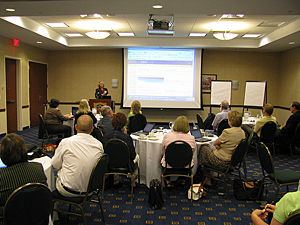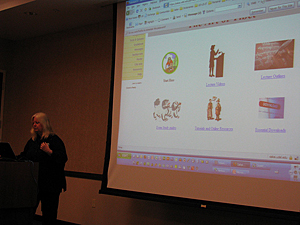- Rozovsky wins prestigious NSF Early Career Award
- UD students meet alumni, experience 'closing bell' at NYSE
- Newark Police seek assistance in identifying suspects in robbery
- Rivlin says bipartisan budget action, stronger budget rules key to reversing debt
- Stink bugs shouldn't pose problem until late summer
- Gao to honor Placido Domingo in Washington performance
- Adopt-A-Highway project keeps Lewes road clean
- WVUD's Radiothon fundraiser runs April 1-10
- W.D. Snodgrass Symposium to honor Pulitzer winner
- New guide helps cancer patients manage symptoms
- UD in the News, March 25, 2011
- For the Record, March 25, 2011
- Public opinion expert discusses world views of U.S. in Global Agenda series
- Congressional delegation, dean laud Center for Community Research and Service program
- Center for Political Communication sets symposium on politics, entertainment
- Students work to raise funds, awareness of domestic violence
- Equestrian team wins regional championship in Western riding
- Markell, Harker stress importance of agriculture to Delaware's economy
- Carol A. Ammon MBA Case Competition winners announced
- Prof presents blood-clotting studies at Gordon Research Conference
- Sexual Assault Awareness Month events, programs announced
- Stay connected with Sea Grant, CEOE e-newsletter
- A message to UD regarding the tragedy in Japan
- More News >>
- March 31-May 14: REP stages Neil Simon's 'The Good Doctor'
- April 2: Newark plans annual 'wine and dine'
- April 5: Expert perspective on U.S. health care
- April 5: Comedian Ace Guillen to visit Scrounge
- April 6, May 4: School of Nursing sponsors research lecture series
- April 6-May 4: Confucius Institute presents Chinese Film Series on Wednesdays
- April 6: IPCC's Pachauri to discuss sustainable development in DENIN Dialogue Series
- April 7: 'WVUDstock' radiothon concert announced
- April 8: English Language Institute presents 'Arts in Translation'
- April 9: Green and Healthy Living Expo planned at The Bob
- April 9: Center for Political Communication to host Onion editor
- April 10: Alumni Easter Egg-stravaganza planned
- April 11: CDS session to focus on visual assistive technologies
- April 12: T.J. Stiles to speak at UDLA annual dinner
- April 15, 16: Annual UD push lawnmower tune-up scheduled
- April 15, 16: Master Players series presents iMusic 4, China Magpie
- April 15, 16: Delaware Symphony, UD chorus to perform Mahler work
- April 18: Former NFL Coach Bill Cowher featured in UD Speaks
- April 21-24: Sesame Street Live brings Elmo and friends to The Bob
- April 30: Save the date for Ag Day 2011 at UD
- April 30: Symposium to consider 'Frontiers at the Chemistry-Biology Interface'
- April 30-May 1: Relay for Life set at Delaware Field House
- May 4: Delaware Membrane Protein Symposium announced
- May 5: Northwestern University's Leon Keer to deliver Kerr lecture
- May 7: Women's volleyball team to host second annual Spring Fling
- Through May 3: SPPA announces speakers for 10th annual lecture series
- Through May 4: Global Agenda sees U.S. through others' eyes; World Bank president to speak
- Through May 4: 'Research on Race, Ethnicity, Culture' topic of series
- Through May 9: Black American Studies announces lecture series
- Through May 11: 'Challenges in Jewish Culture' lecture series announced
- Through May 11: Area Studies research featured in speaker series
- Through June 5: 'Andy Warhol: Behind the Camera' on view in Old College Gallery
- Through July 15: 'Bodyscapes' on view at Mechanical Hall Gallery
- More What's Happening >>
- UD calendar >>
- Middle States evaluation team on campus April 5
- Phipps named HR Liaison of the Quarter
- Senior wins iPad for participating in assessment study
- April 19: Procurement Services schedules information sessions
- UD Bookstore announces spring break hours
- HealthyU Wellness Program encourages employees to 'Step into Spring'
- April 8-29: Faculty roundtable series considers student engagement
- GRE is changing; learn more at April 15 info session
- April 30: UD Evening with Blue Rocks set for employees
- Morris Library to be open 24/7 during final exams
- More Campus FYI >>
2:58 p.m., June 30, 2009----The University of Delaware's Learning Management System (LMS) Committee held its summer retreat June 16 at the Marriott Courtyard Newark-University of Delaware hotel on campus. The theme of the retreat was Using Sakai to Engage Learners.
Pat Sine, director of IT-User Services, opened the meeting with an example of the power of social networking technology and its potential to extend learning opportunities for students. Provost Tom Apple and Mike Middaugh, assistant vice president for institutional research and planning, provided closing remarks that emphasized the importance of increasing student engagement at UD.
In her talk, Sine said, “At the recent Faculty Institute, the keynote speaker, Alec Couros, spoke on “Harnessing the Power of Social Networks in Teaching and Learning” to an audience of 100 people.” The talk was streamed live on the University's Podcast site and through the use of various social networking technologies, and has now been viewed more than 1,900 times. “Because of these technologies, the presentation has been seen far beyond the University,” Sine added.
According to Sine, 21st century skills involve collaboration with people you know and people you don't know. She urged the committee to look at what's happening in Sakai@UD and in the world to discover how they can engage students in all of it.
Throughout the morning, retreat participants explored uses of Sakai@UD and learned of future enhancements.
John Hall, IT-MIS, gave the committee a glimpse Sakai 2.6, slated to be in place on Aug. 18. “In general, people will not have to learn new ways to use Sakai's tools,” Hall said. He added that some sought-after features will be available in the new version.
Instructors will be able to switch to a true student role so that they can see a site as their students see it. Students will be able to resubmit assignments up to 10 times, and custom fields for assignments will let instructors add anything they like.
Hall said that in version 2.6 there will be ICAL integration. This will enable people to subscribe to other calendars they maintain and to see Sakai@UD information in those calendars. Information from their subscribed calendars will also appear in Sakai@UD.
Finally, Sakai 2.6 allows for release of tests and quizzes to specific groups, and settings can be changed on active tests.
Mathieu Plourde, IT-User Services, discussed Sakai 3, a major overhaul due in 2010 that will offer many new features. Plourde said that instructors will be able to imbed objects within pages and add keywords for content searching.
According to Plourde, Sakai 3 will incorporate academic networking and some social networking aspects similar to those available in Facebook. Instructors will be able to add groups to multiple sites. The new version will focus on services rather than tools. Essentially, instructors will be able to create in Sakai whatever they imagine a course to be.
Following the technical updates, three LMS committee members shared how they use Sakai@UD to enhance student engagement.
Students are naturally engaged with getting access to their grades. Don Lehman, Medical Technology, demonstrated how he works with the Sakai@UD gradebook. Lehman exports his roster and grades and downloads the grades to his computer. In Microsoft Excel, he creates a worksheet in CSV format for compatibility with Sakai@UD. There he can work with grades as he chooses and then import them to Sakai.
This process affords more flexibility than working with the grades only within Sakai. The easier it is for him to work with grades, the easier it is for him to give prompt feedback, which is so important to learners.
Jann Sutton, PCS-UD Online, described a Sakai project site she uses for the UD Online Fellows program. This program provides a Sakai experience for faculty so that they can experience the LMS as students. Sutton explained that she renamed the Sakai home page “Start Here” to exemplify one of the standards for online education: clear navigation.
Her project includes a welcome statement with information on how to work with an online course. She also uses RSS feeds to demonstrate engaging students in current events. For example, students can read articles from a particular journal that's updated regularly. Sutton said that an instructor could ask a question in a forum that has students reflect on articles in the RSS feed.
Chandra Reedy, Urban Affairs, wants students to engage with class material in her online Sakai@UD course, Art of Tibet. The course makes use of tutorials and online resources, including a tutorial on Tibetan symbols created in Captivate that incorporates text, visuals, and audio. Students can watch the video multiple times then take quiz to earn points for completing the tutorial. Reedy uses an HTML page for her home page that guides students through the course.
After the talks, the committee participated in breakout sessions on feedback, assessment collaboration and communication to share ideas on how they work and to offer suggestions for improving Sakai@UD. The feedback group noted that feedback tools in Sakai are numerous: assignments, gradebook, blog wow and chat room.
Just as there is no one best way to teach, there is no one best tool for feedback, and faculty need to select one that makes the most sense for them and for their students. Assessment topics included how to use a rubric to let students see the criteria by which an assignment will be graded and how to allow students to see each activity graded as a percent but have tasks weighted differently. The collaboration group focused on forums and wikis and on what makes a meaningful contribution. The discussion of communication centered on several tools and, most importantly, practices that can be used to facilitate communication.
The program concluded with two special messages for the LMS Committee.
Apple, formerly dean of the College and Arts and Sciences who became provost July 1, thanked the committee members for piloting and promoting Sakai. “Adoption has been much faster that anyone anticipated,” Apple said. He added that this spring, there are 1,500 courses and over 200 project sites for professional development and collaboration with colleagues. According to Apple, his goal is to transform students and make them passionate about what they do.
“There is great potential to use Sakai to do this,” Apple said. He said that he is looking to the committee to use Sakai to help make the students' world more collaborative and more interactive and pointed out that Sakai is evolving to enable students to be engaged in learning. Apple offered his appreciation to the committee for the work it does as ambassadors for Sakai@UD. He urged the committee to collaborate with IT to continue to improve Sakai@UD.
Middaugh said that students today learn very differently because they are making incredible use of technology-based tools. “Sakai has many possibilities for reaching these students,” Middaugh said. He discussed the National Survey of Student Engagement (NSSE), which shows statistics on engagement in learning for Delaware students and for those in aspirational schools.
The survey gives benchmarks for such mental activities as synthesizing and organizing information and integrating ideas from multiple classes in one project and then shows how Delaware students match up. “Thinking critically and analytically is one area where UD students could be doing better. Our freshmen report that they do a lot of memorization in classes,” Middaugh said.
He added, “Sakai@UD could be an environment where all these mental activities could occur under the guidance of a faculty mentor. This is an enormous teaching tool for us and an enormous opportunity.”




